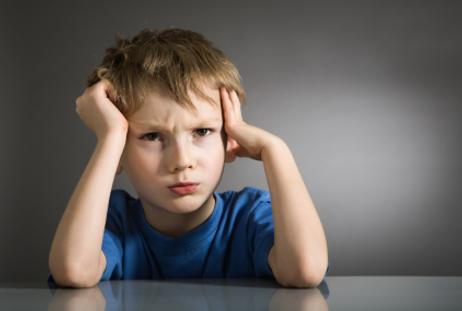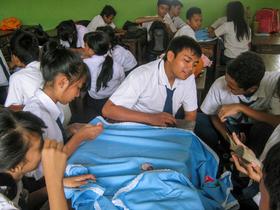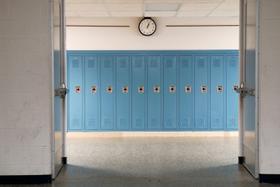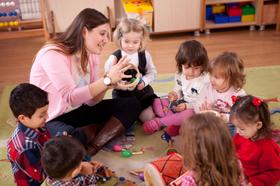As young children are introduced to new academic environments, they often exhibit problematic behaviors. These behaviors may appear as a child struggles to focus, exhibits negative attitudes, begins touching or hitting others inappropriately, and disrespects adults. Addressing and supporting behavioral issues in elementary school is a multi-faceted and collaborative process. By creating a positive and supportive classroom environment, implementing personalized behavior management strategies, teaching self-regulation skills, and fostering strong partnerships with parents and caregivers, educators can help students develop positive behavioral patterns, overcome challenges, and thrive academically and socially. By recognizing the unique needs of each child and providing the necessary support, we can nurture young minds and set them on a path to success.
Parental involvement is important in encouraging a child to act appropriately. Frequently, behavioral problems witnessed at home will manifest at school; therefore, only a joint collaboration between the parents and the teachers can help the student.
To teach students better modes of conduct and behavior, public schools have adopted specific early-intervention programs to help support both students and parents through the developmental process
Why Children Act Out
According to Diana Browning Wright of the Schwab Learning Foundation, specific negative behaviors may be exhibited as a result of a child’s specific learning disability, such as ADHD, autism, or other learning issues; however, many children without learning disabilities also exhibit problematic modes of conduct, as “success in school involves being able to complete work, stay organized, get along with kids and adults, be positive about your own abilities and school, follow rules, and do your best work. But some kids […] may develop behavior problems that add to the risk of failure.”
This video explains why our kids stir up trouble even when they know it's wrong, how to tell if you're caught in a revenge cycle, and some practical tips on dealing.
While children may exhibit problematic behaviors for a myriad of either understood or unknown reasons, Wright further asserts that “before we can understand children's behavior, we must understand their needs. In addition to their physical needs — food, clothing, shelter — kids need fun, freedom, power, and a sense of belonging. If these needs aren't met in positive ways, problems develop.”
In examining children’s needs, oftentimes, some children in the school setting may need to move around and burn off extra energy. This can often stimulate classroom behavior issues. Children often have to sit and learn quietly for hours, so these constraints may prompt behavior problems. For many parents, helping their children overcome these hurdles involves teaching them social skills that are appropriate for their grades.
Adding to this, it is often the case that behaviors are a child’s way of communicating. Perhaps a specific negative behavior is the child’s attempt to explain a hidden complaint or fear. As Wright further explains, “once you understand what her behavior communicates about her needs, you can help her learn more appropriate behaviors.” Parents and teachers can strive to understand a child’s behavior by opening up the child to a discussion about how they’re feeling in school or by meeting for a parent-teacher conference to address specific concerns and issues in order to brainstorm a plan of action. In striving to collaborate in order to help support the struggling child, “when parents, teachers, kids, administrators, and other school staff develop a behavior plan together, success is more likely. Each person needs to understand his role and communicate with others involved. Everyone, not just your child, needs rewards to keep a plan going.”
In this video: Believing that children do well if they can, Debbie is passionate about uncovering and helping other professionals to understand the reasons for disruptive behavior and the right of these children to appropriate services and approaches within mainstream education. ‘There is always a reason for every behavior, we must ask which unmet need is at work here? Then do all we can to find a solution.'
Public Elementary Schools and Behavioral Programs
For students who are exhibiting serious behavior issues and classroom distractions, public schools have designed a program to help focus on the student’s specific conduct issues. In most public schools, children who have behavior conduct disorder or emotional disabilities are enrolled in a program that focuses on behavior modification. In these programs, the student is pulled out of their regular course and is provided with a new set of classes specifically designed to focus on structure and discipline.
Specifically, these public school programs focus on rewards and punishments for altering behavior patterns. For example, a child can “graduate” from the behavior class if they do not experience any “timeouts” or reprimands for disobeying the classroom rules. Once a child is taught the rules and guidelines for positive behavior, the child may return to his or her regular classroom once per month while gradually earning the privilege to attend his or her regular classroom full-time. For many of these programs, if the student can behave appropriately for 90 days, he or she can return to the standard classrooms.
Former classroom teacher Shannon Penrod talks about how to deal with challenging behaviors in a classroom so teachers can get back to doing their jobs. Discussion includes the usual suspects of different behaviors and how to deal with them.
To encourage positive behavior after a child leaves the behavioral program, both teachers and education specialists can monitor their progress in the classroom and in periodic student-teacher conferences. Should the child revert to previous behavior patterns, or is still disruptive in the classroom, then the student will be asked to return to the behavior modification program.
Typically, children who engage in a behavioral program early on are able to combat their negative modes of conduct and are taught how to positively and appropriately engage in their regular environment and surroundings – which will bode well through elementary, middle, and high school.
Questions? Contact us on Facebook. @publicschoolreview















